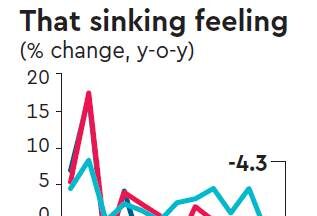By Dr. Gyan Pathak
On June 9, this year, as BJP celebrates 11 years of PM Narendra Modi led government in India as golden period of the country, unemployment rated stood at 6.9 per cent as per Centre of Monitoring Indian Economy (CMIE) data based on 30-day moving average basis. This is the only data available on real time basis in the country.
CMIE’s data on May 30, showed an unemployment rate of 6.7 per cent, which means unemployment slightly rose in the last 10 days. Unemployment rate in April was 7.7 per cent, and in March it was 7.6 per cent.
Union Ministry of Labour and Employment has just started giving monthly Periodic Labour Force Survey (PLFS) data, and the first ever monthly data for April 2025, released on May 15, showed unemployment rate at 5.1 per cent on current weekly status (CWS) basis. Taking into account the large number of unpaid household help as employed, the real unemployment rate on the ground is much higher. It is the situation of unemployment at the completion of 11 years of Modi rule, which has been claimed as “golden period”.
The Report on Employment-Unemployment Survey 2013-14 of the Labour Bureau of the Union Ministry of Labour and Employment, Unemployment in the country was 4.9 per cent. PM Narendra Modi became prime minister of India in May 2014, after vigorously campaigning against the UPA government, saying that the unemployment rate was very high, and if he would come to power, he would provide ‘work to every hand’ that is 2 crore people who were entering the workforce every year. Nevertheless, by 2017-18, unemployment rose to 6.1 per cent which was 45 years high.
A comparison of the unemployment data of the government, it is clear that there has never been a “golden period” for the unemployed. Though PM Narendra Modi claimed generating about 2 crore jobs every year, unemployment remained at very high level even when the government started enumerating unpaid household help as employed, and also excluding those from unemployed who have stopped searching jobs out of frustration, since there was no job available in the job market.
Unemployment rate in 2013-14, was 4.9 per cent, and in April 2025, it was 5.1 per cent. Urban unemployment rose from 5.5 per cent to 6.5 per cent during this period. Rural unemployment was 4.7 per cent when PM Modi came to power. Now in April 2025, it was 4.5 per cent.
Male unemployment rate was 4.1 per cent in 2013-14 while female unemployment rate was 7.7 per cent. In urban areas, male and female unemployment rates were 3.9 per cent and 12.4 per cent respectively. In rural areas, male and female unemployment rates were 4.2 and 6.4 per cent.
In April 2025, male and female unemployment rate in urban areas were 5.8 per cent and 8.7 per cent respectively. In rural areas male and female unemployment rates were 4.9 per cent and 3.9 per cent respectively.
Even in this worsened unemployment scenario, government has tried to sell its “golden period” claim by repeatedly mentioning false data, since May 2024, during the Lok Sabha election. Since government has not data on employment on its own, it just picked up KLEMS data of the Reserve Bank of India, and claimed on its basis that 17.19 crore jobs were created between 2014-15 and 2023-24, that is almost 2 crore jobs every year, as promised by Narendra Modi.
One can ask a simple question – why Modi government don’t have its own data in employment? Obviously, the government have not been interested in such data. Secondly, they don’t have any accountability on the correctness of data, when they quote RBI’s data to tell the country about job generation.
Nevertheless, RBI data was false. How and why it was compiled, remains a mystery. One can see it oneself. While millions of MSMEs and jobs therein were lost in 2016-17 due to demonetisation, it showed rise in employment from 47.1 crore in 2014-15 to 47.3 crore. When entire economy was shut down in 2020-21, and 2021-22 due to COVID-19, it showed employment even more at 56.6 crore, and 57.8 crore. It showed employment even higher at 59.9 crore in 2022-23, and 64.3 crore in 2023-24. Falsity of the data was stark for the year 2020-21, when GDP was a negative (-)5.8 per cent but employment shown rose to 56.6 crore. The “golden period” for employment was thus ushered in through false data.
Now come the latest unemployment data of April 2015. The government has revamped the PLFS methodology of 2017-18, which was launched by the Modi government to replace the old government data collection methodology. PLFS could however, successfully brought down the unemployment data to 3.2 per cent in 2024 on usual status basis, which was calculated at 4.9 per cent on CWS basis.
It should be noted here that the definitions of employment and unemployment were changed in the PLFS, to show better pictures of employment and unemployment. The definitions and methodology have changed again in January 2025, to show even more better pictures. Nevertheless, the first PLFS data for April 2025, does not show any golden impact of Modi rule. Unemployment rate among youth between 15-29 years was as high as 13.0 per cent which remains a serious concern.
Labour Force Participation Rate (LFPR) in 2013-14 was 52.5 per cent and Worker Population Ratio (WPR) was 49.9 per cent. In April 2025, these figures stood at 55.6 per cent and 52.8 per cent, even after enumerating large number of unpaid household help as employed.
The reality on is more frightening on the ground. Workforce have been under great duress under the so called “golden period” of Modi’s 11 years of rule. Unemployment, unpaid employment, underpaid exploitative employment are rampant. Modi’s claimed “golden rule” seems to be benefitting only the profiteering companies and businesses, causing inequality widening sharply. (IPA Service)




 Trump Targeting Ivy League Universities Is Part Of Ideological Fight Against Democrats
Trump Targeting Ivy League Universities Is Part Of Ideological Fight Against Democrats 